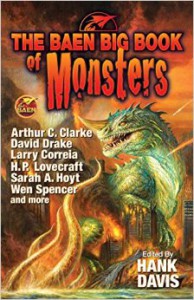written by David Steffen
I’ve been following the Hugos closely for several years, trying to read and review as many of the nominated works as I can digest between the announcement of the ballot and the final deadline. I also follow the Nebulas, and I glance at the results from other SF genre awards, but for me the Hugos take up most of my attention come award season. With this eventful Hugo year, it crossed my mind to wonder why the Hugos specifically, and whether I might perhaps be better off devoting more of my attention to awards that don’t collect controversy the way the Hugo Awards always seem to do, and in escalating fashion these last few years.
1. The Hugos are Fan-Based.
Specifically, they are based on the supporters/attendees of WorldCon, which is certainly not an exact representation of fandom as a whole. But what I mean by this is that the fan-based nature differentiates it from juried awards or the Nebulas which are voted by SFWA members, which gives that award a very different feel.
I do like the concept of the Locus Awards, since those are available for anyone to vote online, so have a broader voting audience–maybe I’ll try to pick them up next year.
2. The Hugos Have a Long Reading Period
The Nebulas and the Locus awards have very short reading periods (the period of time between the announcement of the ballot and the voting deadline) of only about a month. If I want to read as much of the fiction as possible, that’s not nearly enough time–I can’t finish all the short fiction, let alone start the novels. The Hugo ballot is announced around Easter weekend (usually early April or so) and the voting deadline is at the end of July, so there are nearly four months to try to do all the reading. The Hugo Packet isn’t released right at the beginning of the reading period, but usually enough of the short fiction was published in online venues so that I can fill my reading time with Hugo material.
3. The Hugos Have Instant Runoff Voting and No Award
The Nebula ballot for each category is a set of radio buttons–you can only choose one winner. On the Hugo ballot you can give a numeric vote from 1 to N, where N is the total number of nominees (usually 5). All of the voters first choices are tallied, and the story with the lowest votes is eliminated–all of the ballots which had the eliminated story as the top vote slip down to their second choices, and so on, until there is a winner. I like this because it’s a very common situation where I like more than one of the nominees a great deal, and this lets me give support for more than one instead of having to choose. This is also beneficial if the same author has more than one story in a category because they don’t self-compete.
There is also a No Award vote that lets you differentiate between items you don’t care about and items you strongly feel should not win. If there is a large enough portion of No Award votes, no awards will be given for the category, which gives a recourse in the case that you think a category has nothing worthy.
4. The Hugos have a Graphic Story Category
I love graphic stories, but I have not been very good at keeping up with them. The graphic story category gives me a sampler of what the graphic stories that people loved the most so that I can catch up a bit, maybe even consider picking up a subscription. This year’s category was especially stellar, with three comics that I’d consider picking up–which I reviewed here a few weeks ago.
5. The Hugos Have WorldCon
I made it to WorldCon 2012 in Chicago, and had a really great experience there. That was before the launch of the Submission Grinder, so less people knew who I was, but I still knew a lot of people from Writers of the Future and Codex. There were a lot of my favorite writers and editors there, probably partly due to the Hugos drawing them to the award ceremony. I also thought it was fun to go to the award ceremony itself.
6. The Hugos Have the Hugo Packet
A lot of the short fiction is available for free without actually becoming a Hugo voter–a lot of it was published for free online to begin with, other publishers (like Analog) post it there for the readers to see. But most of the ones that aren’t available for free are in the packet, and most years most of the novels have been included as well.
This is based on kind of an odd dynamic. The Hugo packet is only a few years old, so it’s a nice convenience. If the Hugos were less notable, the publishers probably wouldn’t participate. If the Hugo voting audience was huge, the publishers might be reluctant to give away that many free copies. So it works in kind of an odd middle space where most science fiction and fantasy readers are aware of the award, enough that pasting the name on a book cover can encourage sales, but not so many actually participate (even though they all can) to deter publishers.
7. The Hugo Rules/Categories are Chosen By Fans
OK, this one is alternately a benefit or a detriment. A benefit because as new formats of science fiction and new publishing technologies become popular, the award can expand to include those things, and theoretically phase out those things that are outdated. A detriment because it can sometimes end up with some long-lasting categories that don’t make a lot of sense, or new categories thrashing out of momentary conflicts. But I like the idea in theory anyway.

